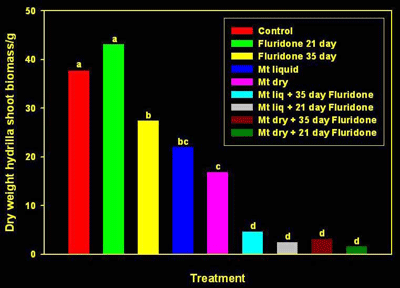|
We have research information for you on integrating Mt with chemical herbicides.
As you may recall, the main goal of the Hydrilla IPM project is to integrate different control methods into a sustainable hydrilla management plan. A possible bio-herbicide investigated in this project is the fungus Mycoleptodiscus terrestris (Mt). Substantial research has been conducted over the past 17 years to evaluate the efficacy of Mt in reducing hydrilla biomass, especially when Mt is combined with different chemical herbicides.
While a single control agent (be it biological or chemical) may not reduce hydrilla populations to tolerable levels, combining two (or more) agents may do the job. Why? Although each type of control measure may not be damaging by itself, it may weaken the weed enough to make it more susceptible to the actions of another control measure.
What's even better: Risk of resistance development should be low when the weed is exposed to different types of control agents. Another benefit of combining different tactics: Usually, compared with single-agent treatments, lower rates of each control agent can be applied to achieve control when two agents are combined.
Is this also true for Mt and chemical herbicides? Yes, data from tank experiments are promising! The following combinations have been tested:
Mt + fluridone: Significant biomass reduction or complete control were achieved while using a low fluridone rate (2 ppb) that would not be lethal when applied alone (read full publication by Netherland and Shearer 1996). Minimal effect by combination treatments on non-target, endemic species was observed (read full publication by Nelson et al. 1998).
Mt + endothall: Adding Mt significantly increased efficacy of endothall, especially at low rates (0.25 and 0.50 ppm) and short exposure times (read full publication by Shearer and Nelson 2002). Effects on non-target species varied but indicated recovery over time (results also available in Shearer and Nelson's 2002 publication).
Mt + diquat: Combining Mt and diquat (at different rates and exposure times) reduced hydrilla biomass significantly more than either treatment applied alone (read full publication by Nelson and Shearer 2009).
In summary, combining Mt and chemical herbicides provides the following benefits:
- Quick action of Mt causes high initial biomass reduction
- Chemical herbicide prevents weed recovery
- Mt increases efficacy of chemical herbicide at low rates and short exposure times
- At low application rates and/or low exposure times, non-target effects of Mt and of the chemical herbicide are minimal or allow recovery

Source: Judy Shearer, U.S. Army Corps of Engineers, Engineer Research and Development Center
As always, we acknowledge the funding provided by the U.S. Department of Agriculture, National Institute of Food and Agriculture, Risk Avoidance and Mitigation Program (grant 2010-02825).
|